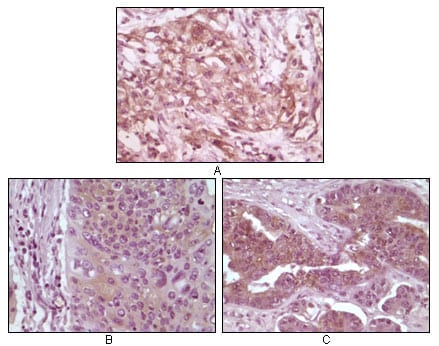
| WB | 咨询技术 | Human,Mouse,Rat |
| IF | 咨询技术 | Human,Mouse,Rat |
| IHC | 1/200 - 1/1000 | Human,Mouse,Rat |
| ICC | 技术咨询 | Human,Mouse,Rat |
| FCM | 咨询技术 | Human,Mouse,Rat |
| Elisa | 1/10000 | Human,Mouse,Rat |
| Aliases | BP-1; 4EBP1; 4E-BP1; PHAS-I; MGC4316; EIF4EBP1 |
| Entrez GeneID | 1978 |
| clone | 4B6G10 |
| Host/Isotype | Mouse IgG1 |
| Antibody Type | Primary antibody |
| Storage | Store at 4°C short term. Aliquot and store at -20°C long term. Avoid freeze/thaw cycles. |
| Species Reactivity | Human |
| Immunogen | Purified recombinant fragment of 4E-BP1 expressed in E. Coli. |
| Formulation | Ascitic fluid containing 0.03% sodium azide. |
+ +
以下是3篇关于4E-BP1抗体的参考文献摘要概括:
---
1. **文献名称**: "Regulation of 4E-BP1 phosphorylation by mTOR"
**作者**: Gingras AC, et al. (1999)
**摘要**: 该研究利用特异性4E-BP1抗体,通过免疫印迹和免疫沉淀技术,揭示了mTOR激酶通过调控4E-BP1的磷酸化(如Thr37/46位点)影响其与eIF4E的结合能力,从而调节蛋白质翻译起始的分子机制。
---
2. **文献名称**: "A unifying model for mTORC1-mediated regulation of mRNA translation"
**作者**: Thoreen CC, et al. (2012)
**摘要**: 通过多种4E-BP1磷酸化特异性抗体(如抗p-Thr37/46和p-Ser65抗体),本研究阐明了mTORC1信号通路对4E-BP1不同磷酸化状态的动态调控,及其在细胞应激条件下对翻译重编程的作用。
---
3. **文献名称**: "The roles of 4E-BP1 in neurological disorders: from translation to pathology"
**作者**: Choo AY, Blenis J (2009)
**摘要**: 该综述总结了4E-BP1抗体在神经退行性疾病研究中的应用,包括通过Western Blot和免疫组化检测脑组织中4E-BP1的表达及磷酸化水平变化,探讨其与阿尔茨海默病等疾病的关联。
---
4. **文献名称**: "Insulin-dependent stimulation of protein synthesis by phosphorylation of a regulator of 5'-cap function"
**作者**: Pause A, et al. (1994)
**摘要**: 早期研究报道了针对4E-BP1抗体的开发与应用,首次证明胰岛素通过磷酸化4E-BP1解除其对eIF4E的抑制,促进帽依赖性翻译,为后续抗体在代谢调控研究中的广泛应用奠定了基础。
---
这些文献涵盖了4E-BP1抗体的技术应用、磷酸化检测及功能机制研究,适用于信号通路分析与疾病模型研究。
The 4E-BP1 (eukaryotic translation initiation factor 4E-binding protein 1) antibody is a crucial tool for studying cellular translation regulation and mTOR signaling. 4E-BP1 acts as a suppressor of cap-dependent mRNA translation by binding to eIF4E, a key component of the translation initiation complex. Its activity is primarily regulated through phosphorylation by the mTORC1 kinase. When mTORC1 is active, phosphorylated 4E-BP1 releases eIF4E, enabling the assembly of the translation initiation machinery. This phosphorylation occurs at multiple sites (Thr37/46. Ser65. Thr70), with distinct functional consequences.
Antibodies targeting 4E-BP1 are widely used to detect its expression levels and phosphorylation status in studies of cell growth, proliferation, and stress responses. They help evaluate mTOR pathway activity in various contexts, including cancer research, where dysregulated 4E-BP1 phosphorylation is linked to tumor progression and therapy resistance. Specific antibodies can distinguish between total 4E-BP1 and its phosphorylated forms, providing insights into dynamic regulatory mechanisms. These reagents are essential for techniques like Western blotting, immunoprecipitation, and immunofluorescence. Recent studies also explore 4E-BP1's role in metabolic disorders, neurodegenerative diseases, and aging, expanding the antibody's research applications. Proper validation remains critical due to phosphorylation-state specificity requirements and potential cross-reactivity with other 4E-BP family members.
×